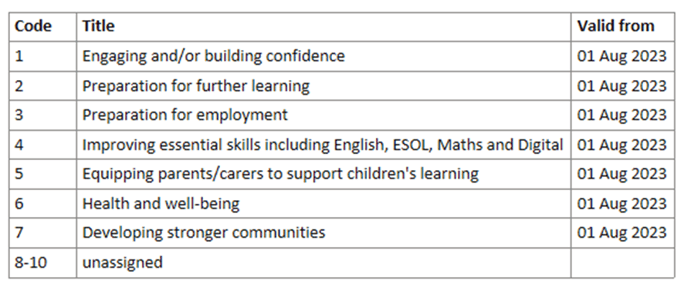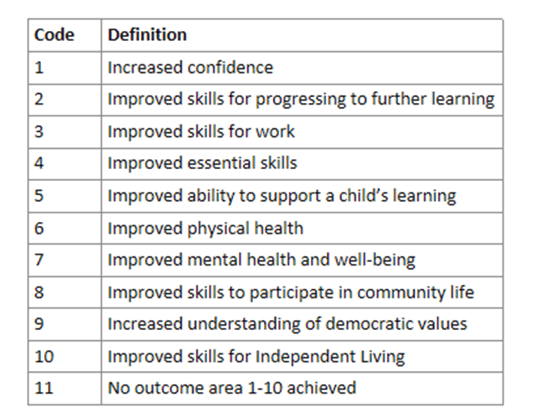Changes to Adult Skills for 2024/25
The Department for Education has given providers an indication of some of the changes to the ILR (Individualised Learner Record) for 2024/2025. In this blog, Matthew Butson, Tribal’s Senior Funding & Reporting Adviser explains those changes – and the likely impact on your funding.
What is Tailored Learning?
Those of us who have worked in this space for many years will find something shocking in the ILR specification for 24/25. Tailored Learning (FM11) and the Adult Skills Fund (FM38) are replacing Community Learning (FM10) and Adult Skills (FM35). The published funding rules describe tailored learning as follows:
As part of the new ASF, the term tailored learning brings together what was AEB community learning, formula-funded AEB non-regulated learning (previously delivered through adult skills) and any new employer-facing innovative provision that is not qualification based. The primary purpose of tailored learning is to support learners into employment and to progress to further learning, in line with the overall purpose of the ASF. It will, however, also support wider outcomes including using it to improve health and wellbeing, equip parents/carers to support their child’s learning and develop stronger communities." [1]
The Adult Skills Fund allocations for 24/25 were published on 21st March 2024 and providers will have seen a rebalancing in the amounts allocated between the new Adult Skills Fund and the new Tailored Learning provision. How much this has rebalanced will depend on how much non-regulated provision your organisation has previously delivered under the old Funding Model 35. The approximate value of that should now be included your tailored learning allocation.
How does it work?
Whilst the performance management rules for 24/25 have not yet been published, we do have the broad outlines, even if we do not have the fine detail.
What we know so far.
Whilst the new tailored learning funding model will align much more closely with the old community learning model in its administration and governance, it will vary in some important ways.
Tailored learning delivery will be reconciled with the allocation at the end of the year, and any unused funds will be recovered. How this will work is unclear at this stage, but it will likely be via a declaration in the submitted funding claims, much as Community Learning is currently done.
Providers will also have limited flexibility to use tailored learning funds to deliver regulated provision:
You can use this amount of tailored learning funding (stated in your appendix 1) to deliver regulated provision to meet local demand. If you do deliver regulated learning, you must enroll learners following ESFA funded ASF eligibility requirements set out in the government contribution chart 1 and chart 2." [2]
The new funding model will also have its own dedicated learning aims. These are already available on the Find a Learning Aim site. For new starts after the 1st of August, the old Community Learning codes and Adult Skills Z codes will no longer be valid. It is interesting to note that of the approximately 4500 aims already published as Tailored Learning, only 124 are the non-regulated aims, the rest are regulated aims that could be delivered as tailored learning as part of the above flexibility.
New Fields
In 23/24 the Community Learning Purpose replaced the old ASL Provision Type. This was intended for the learner to define their purpose for studying the course. The options are given below: [3]
This field is retained but renamed as the Tailored Learning Purpose in 24/25.

In addition, there will also be the Tailored Learning Outcome Area to be completed when the learner has completed or withdrawn. The current options are shown below: [4]

It is important to note that the outcome area does not need to match the purpose type as learners can develop their skills in unexpected ways during their learning. The ILR specification also contains some useful notes to clarify these options.
In summary, the providers I work with have seen a modest but welcome increase in their overall allocation after years of frozen Community Learning budgets. Some also might welcome a lower Adult Skills target to reach because the non-regulated elements have moved to the tailored learning total; however, it does mean that providers cannot now offer a mix of regulated and non-regulated provisions to meet local demand within FM38. The new funding model will be for exclusively regulated provision, except for explicitly defined programmes such as Multiply or OLASS, etc so providers will have to plan provision more carefully to avoid under-delivery. This is particularly important if providers had an atypical delivery pattern in previous years that could skew the planning in 24/25.
On an admin level, providers will be changing all their non-regulated Z codes to prepare for tailored learning, and having to update their enrolment processes to ensure the new ILR fields are included.
Beyond that, we will have to wait and see how this new provision is performance managed, how it will be audited, and if it is included in the QAR statistics.
Matt leads a team of funding and compliance experts supporting providers with their day-to-day data management and all things ILR. You can find out more about our Data Management Services here, or view our ebs page here.
[2] From <https://www.gov.uk/government/publications/adult-skills-fund-funding-rules-for-2024-to-2025/adult-skills-fund-funding-rules-2024-to-2025#tailored-learning->
[4] From <https://guidance.submit-learner-data.service.gov.uk/24-25/ilr/entity/LearningDelivery/field/TLOut>
TOPICS:
Skills, Training and Employability
SHARE THIS ARTICLE:


